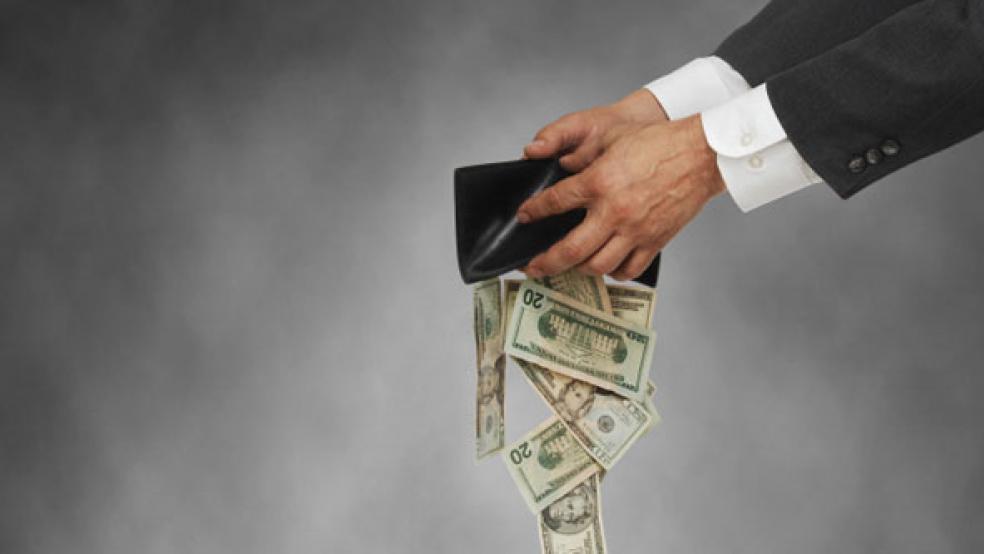Owing large amounts of money can keep you from getting a good night’s sleep or enjoying any purchase that you may make. Getting out of debt can be even scarier.
The average U.S. household with credit card debt owes $15,355, according to a 2015 study from NerdWallet. Households that have student loans owe $47,712 on average. Those can be daunting figures when you’re trying to find a way out of the red.
“It’s simply about taking baby steps,” says Eric Roberge, wealth coach and founder of Beyond Your Hammock in Boston. “By putting one foot in front of the other, you actually make progress. It is not going to happen all at once.”
Here are 11 steps that will help you become debt-free.
1. Know what you’re dealing with. Start with a full summary of all your outstanding debt, says Taylor Schulte president of Define Financial in San Diego. For each debt, list the outstanding amount, term, interest rate, minimum payment and miscellaneous fees.
Related: Here Are 3 Ways to Get Out of Credit Card Debt Now
“It's important that you gain a clear understanding what the overall picture looks like so you can develop a plan to tackle it,” Schulte says.
2. Set a timeline. Now that you know what your debt situation looks like, set a realistic time frame for paying off each one, says Roger Stinnett, managing director of wealth planning of First Foundation in Los Angeles. Do a little math to figure out if this is attainable.
“For example, if you wanted to pay off a $25,000 debt in three years,” Stinnett says, “then this would be $8,333 per year, and further, $694 a month.” If that monthly payment is realistic, then keep your timeframe. If it isn’t, adjust accordingly, either by extending the deadline, or figure out where you can save each month to increase your payment. To do that, see No. 3.
3. Make a budget. After tracking your spending for at least a month, set a budget. This will show where you spend the most money and where you can cut back. For example, if you see that you spend a lot of money on going out to eat, maybe limit how many times you do this each month. Make your lunch instead of buying it. Monitor your budget monthly and adjust where needed, says Stinnett.
“Sometimes unexpected expenses come up that take priority,” says Stinnett, “but don't let that derail you from your goal.”
4. Automate payments for all of your loans. This allows you to set it and forget it, while also helping to reduce the stress that can come with making monthly payments.
Related: Why Millions of Millennials Can’t Get Credit Cards
“I also recommend that clients pay off an additional amount each month with their base payment,” says Arthur Ebersole of Ebersole Financial in Wellesley Hills, Mass. “Even small amounts--$5 to $10--can have a big impact in reducing overall debt levels and the amount of interest paid over time.”
5. Use extra funds wisely. Ebersole also recommends using windfall payments, such as a work bonus or tax refund, to pay down debt. “These are funds that are generally not needed for day-to-day expenses,” he says, “so using them to repay debt should not cause any undue hardship.”
While paying off debt, ask for money for holiday and birthday gifts from family. They probably won’t be offended if you tell them about your debt-free goal.
6. Ask for a break. Before paying down any debt, call your lender and request a rate reduction, says Schulte. If you have incurred any recent late fees, ask for a reimbursement. If you’re turned down, try again after several months of timely payments. “It never hurts to ask and you might be surprised how successful you are,” Schulte says.
7. Go for the biggest interest rate first... The rule of thumb when it comes to several outstanding debts is to get rid of the one with the highest interest rate first. Pay as much as you can on this debt, while paying at least the minimum on other debts, says David Mullins of David Mullins Wealth Management at Richlands, Va. When that debt is paid off, move on to the debt with the next highest interest rate, implementing the same strategy.
“This technique will work and keep you from becoming overwhelmed by spreading your money around too thin without seeing any progress,” says Mullins.
8. …Or go for the smallest debt first.
While paying the highest interest loan first is the best approach mathematically, some people feel discouraged if they don’t see progress fast, says Jonathan Swanburg, investment associate at Tri-Star Group in Houston.
Related: Americans Just Went on a $32 Billion Credit Card Shopping Spree
“Unfortunately, the math doesn’t work if you can’t stick with the plan,” he says. “Psychologically, it is often easier to get started by paying off the loan with the lowest balance.”
He says the excitement of seeing a debt disappear quickly provides more incentive to keep paying down debts.
9. Tackle debt with debt. Consider the myriad ways you can transfer existing debt from one type of loan to one with a lower interest rate to hasten your debt reduction. For example, many credit card companies offer zero interest for a limited time on balance transfers. Find an offer that fits your timeframe—many balance transfer time limits are between 6 months and 18 months. Make sure to figure in any fees—usually 3 percent of the outstanding balance—to determine if a transfer is financially better.
Homeowners can consider home equity, too, says David Demming, president of Demming Financial in Aurora, Ohio. Demming said one of his clients shifted the debt on their credit cards to a home equity line of credit with a lower interest rate.
“Second example was refinancing a couple to one lower-rate mortgage but eradicating all outside debt,” by pulling cash out of the house, he says.
10. Know your options with student debt. Those struggling with student loans have a few choices depending on the type of debt. Private loans can be consolidated, says Betsy Mayotte, director of regulatory compliance at American Student Assistance. At the very least, lenders can extend the term and lower the monthly payment. If your credit score is good, the lender may lower the interest rate.
City, state and federal employees can take advantage of the government’s public service loan forgiveness program for federal loans. Just make payments for 10 years and the remaining debt is forgiven in the end, says Mayotte.
Another federal program is an income-driven payment plan where the student loan is forgiven at the end of plan, usually 20 to 25 years out, Mayotte says. She notes that the forgiven amount is taxed as income at the end.
11. Don’t psyche yourself out. Paying back a large amount of debt can be battle of wills. To help you stay focused, use visual reminders to reinforce why you want to pay off debt, says Niv Persaud, managing director of Transition Planning and Guidance in Atlanta.
“Tape a note to your credit card or where you can see it several times a day,” she says. Another idea is to break down your total debt amount into smaller targets, especially if your timeframe is over years.
Last, reward yourself, says Stinnett, and work that into your budget. One idea: “A nice dinner to reward yourself for the success of paying off your debt.”





